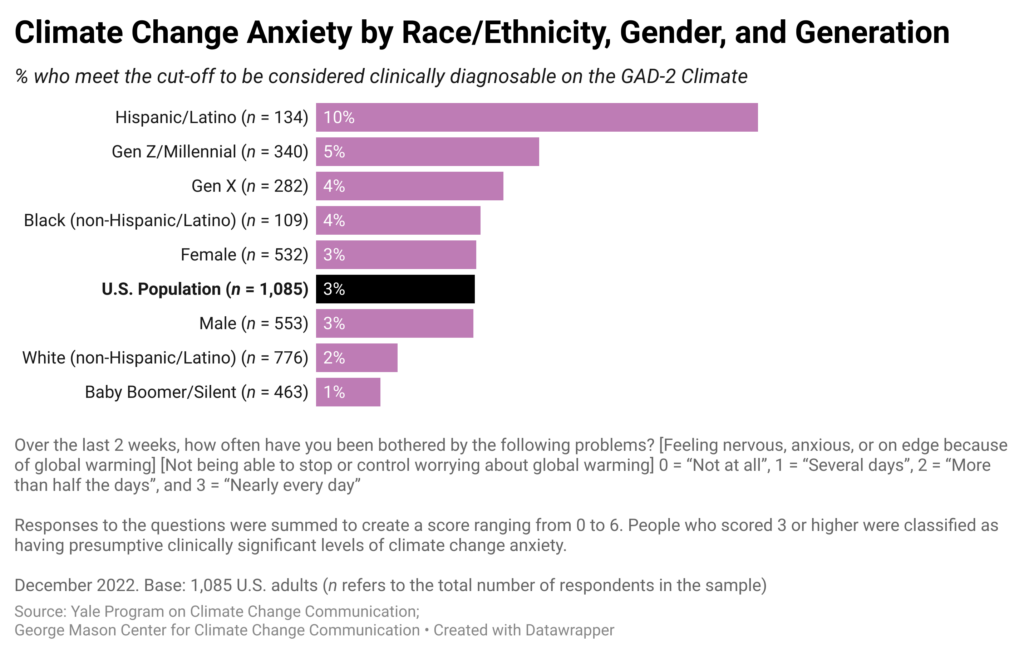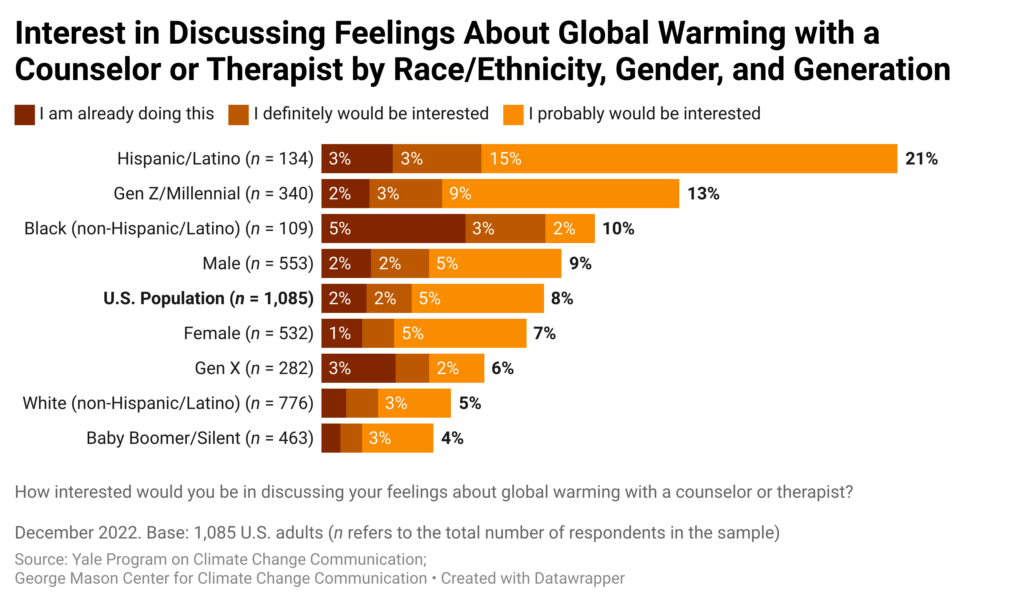Climate Note · Jul 25, 2023
The prevalence of Climate Change Psychological Distress among American adults
By Sri Saahitya Uppalapati, Matthew Ballew, Eryn Campbell, John Kotcher, Seth Rosenthal, Anthony Leiserowitz and Edward Maibach
Filed under: Audiences and Beliefs & Attitudes
Climate change is increasingly harming mental health. While recent studies have indicated high rates of climate anxiety in various populations – especially young people – validated short measures of climate change-related psychological distress have yet to be developed. Screening tools to identify people who may be experiencing potentially serious levels of psychological distress from climate change can help assess its presence and the need for appropriate interventions.
We modified two previously validated and widely used mental health screening tools – the Generalized Anxiety Disorder-2 instrument (GAD-2) and Patient Health Questionnaire-2 instrument (PHQ-2) – to assess the prevalence of climate change-related anxiety and depression, respectively. Following the practice established in the mental health literature (i.e., PHQ-4), the two modified tools were combined to form a 4-item composite measure to assess overall Climate Change Psychological Distress (CCPD). In the December 2022 Climate Change in the American Mind survey, we used these modified measures to assess the prevalence of climate change-related anxiety (GAD-2 Climate), depression (PHQ-2 Climate), and CCPD among American adults.
The measures included the following questions: “Over the last 2 weeks, how often have you been bothered by the following problems?” (1) Feeling nervous, anxious, or on edge because of global warming, (2) Not being able to stop or control worrying about global warming, (3) Little interest or pleasure in doing things because of global warming, and (4) Feeling down, depressed, or hopeless because of global warming. The response options included: 0 = “Not at all,” 1 = “Several days,” 2 = “More than half the days,” and 3 = “Nearly every day.”
To measure GAD-2 Climate, the scores for items 1 and 2 were summed to create a scale ranging from 0 to 6. Consistent with previous research using the GAD-2, people who scored 3 or higher on this measure were classified as having potentially serious levels of climate change anxiety. Similarly, for PHQ-2 Climate, the scores for items 3 and 4 were summed to create a scale ranging from 0 to 6. People who scored 3 or higher were classified as having potentially serious levels of climate change depression. For CCPD, consistent with previous research using PHQ-4, scores for all four items were combined into a scale ranging from 0 to 12 and were categorized as normal (0 to 2), mild (3 to 5), moderate (6 to 8), and severe (9 to 12).
We found that 3% of American adults scored above the cutoff on the GAD-2 Climate measure, which suggests they may be experiencing potentially serious levels of anxiety due to climate change. Hispanic/Latino adults are especially likely to be experiencing high levels of climate anxiety (10%) compared to Black Americans (4%) and Whites (2%). Further, Gen Z and Millennials and Gen X are experiencing a higher rate of climate anxiety (5% and 4%, respectively) compared to Baby Boomers and older adults (1%).
Similarly, 3% of American adults scored above the cutoff on the PHQ-2 Climate measure, suggesting they may be experiencing serious levels of depression due to climate change. Hispanic/Latino adults (10%) are much more likely to experience climate change-related depression compared to Black Americans (3%) and Whites (2%). Additionally, Gen X (5%) and Gen Z and Millennials (4%) are more likely than older adults (1%) to suffer from climate change-related depression.
Overall, 7% of American adults are experiencing at least mild levels of climate change psychological distress (CCPD). Hispanic/Latino adults (17%) are significantly more likely to be experiencing mild or higher levels of CCPD as compared to Black Americans (5%) and Whites (5%), and they have the highest rate of severe CCPD (3%) compared to all other race/ethnicity, gender, and age cohorts. Gen Z and Millennials (10%) and Gen X (8%) are more likely than Baby Boomers and older generations (3%) to experience at least mild levels of CCPD.
The survey also included an item that assessed respondents’ interest in discussing their feelings about global warming with a counselor or therapist. Currently, 8% of American adults say they would either “probably” (5%) or “definitely” (2%) be interested in discussing their feelings about global warming with a counselor or therapist or are already doing so (2%). There are significant racial/ethnic differences in these rates. Hispanics/Latinos (21%) are significantly more likely than the other groups to say they are interested in or are already having discussions with a therapist or counselor about their feelings about global warming. Notably, 10% of Black Americans say they are either already involved in these discussions (5%) or would be interested in them (5%). By contrast, fewer White Americans (5%) say they are either interested in having these discussions or already are.
Within age cohorts, Gen Z/Millennials (13%) are more likely than Baby Boomers and older adults (4%) to say that they are interested in or are already discussing their feelings about global warming with a therapist or counselor. Among Gen X, 3% are seeking support while 3% say they are either “definitely” or “probably” interested in doing so.
These findings indicate that many Americans are receptive to seeking mental health support to address their feelings about global warming. This highlights the crucial role of healthcare systems in ensuring support is available to those who express a desire to seek assistance.
In summary, we find that Hispanics/Latinos and younger generations of adults are among the groups most likely to experience potentially serious levels of anxiety, depression, and psychological distress due to their concern about climate change. They are also more likely to be discussing, or to potentially want to discuss, their feelings about climate change in counseling and therapy. Although feeling anxious, depressed, or distressed is an understandable and rational response to the threat of climate change, experiencing it at a clinically relevant level may negatively impact both one’s well-being and capacity to participate in efforts to address climate change.
The measures we developed are concise and easy to implement, making them potentially useful in both research and practice situations. However, these measures have not yet been validated and are only intended for use as screening tools; they cannot replace the need for a thorough diagnostic evaluation. Promoting mental health and developing strategies to strengthen psychological resilience in the face of a changing climate is imperative to protect people’s health and well-being.
To learn more about climate mental health resources, please visit the resources provided by the Climate Mental Health Network.
Methods
The results of this report are based on data from the December 2022 wave (n = 1,085) of the twice-yearly Climate Change in the American Mind survey – a nationally representative survey of U.S. public opinion on climate change conducted by the Yale Program on Climate Change Communication and the George Mason University Center for Climate Change Communication. Data were collected from December 2 – 12, 2022 using the Ipsos KnowledgePanel®, a representative online panel of U.S. adults ages 18 and older. Questionnaires were self-administered online in a web-based environment.
Data were weighted to align with demographic parameters in the United States. Following Pew Research Center’s approach, generational cohort and year of birth were calculated based on the age of respondents at the time of data collection (Gen Z: 1997-2012; Millennial: 1981-1996; Gen X: 1965-1980; Baby Boomer: 1946-1964; and Silent Generation: 1928-1945). Because generational cohort classification was based on respondents’ age at the time they took the survey (rather than the birth year, which was not known), some respondents on the cusp of two generations may be miscategorized. We are unable to describe the views of other racial/ethnic groups (including Asian Americans, Native Americans, and adults who identify with 2+ races) because of sample size limitations. The average margin of error is +/- 3 percentage points at the 95% confidence interval for the full sample of U.S. adults (n = 1,085). Importantly, due to small sample sizes, the average margins of error at the 95% confidence interval for Black (+/- 9.4 percentage points) and Hispanic/Latino (+/- 8.5 percentage points) respondents are larger than for other groups, and thus results should be interpreted with caution.
In figures/data tables, bases specified are unweighted, while percentages are weighted to match national population parameters. Percentage points are rounded to the nearest whole number for tabulation purposes and summed categories (e.g., “I am already doing this” + “I definitely would be interested” + “I probably would be interested”) are rounded after sums are calculated (e.g., 1.65% + 1.61% + 4.83% = 8.09%, which, after rounding would appear in this report as 2% + 2% + 5% = 8%). The data tables used to develop the charts/figures can be found here.



